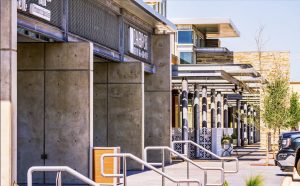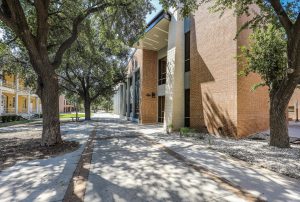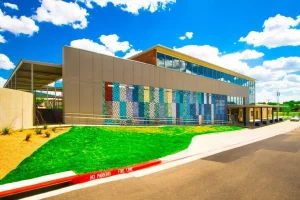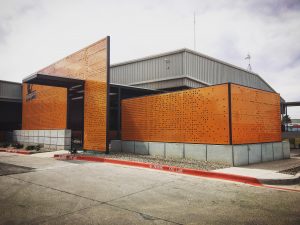Juan Garza is an Associate at Able City. Juan has helped lead many of Able City’s most celebrated projects — including the Laredo College Cigarroa Science Complex, which took home the AIA LRGV’s highest honor at the end of last year. See below for our Q-and-A, where Juan speaks to his path to architecture, and why — especially in producing high quality work — more time can also take you farther.
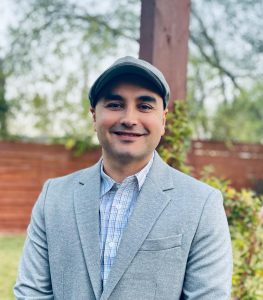
Able City (AC): Did you always know you wanted to be an architect?
Juan Garza (JG): From an early age, I thought I was going to be one. I have always been a very creative person. At one point in my life I didn’t know if I was going to be an engineer or an architect, so I visited both schools as I was deciding what path to take. I ended up deciding on architecture. I went for four semesters and then had to stop and figure out if I liked it enough to continue, or if I wanted to move to civil engineering.
When I asked my favorite teacher, he said architecture was like the point of the pyramid — if I wanted to move to engineering after that I could. I decided to stay in architecture, and in my fifth semester (2004), I started working — and I fell in love with the career. My boss at that time became my first mentor.
AC: What was it about working that inspired you more than studying?
JG: My boss’s passion was contagious. I couldn’t wait every day to get out of school to go to work. It was amazing to learn from him. I did 1000 house floor plans for him because he liked perfection. He used to ask me for something and I’d say, I’m done, until one day he told me, don’t say that again. You’re never done. You always have room for improvement.
He asked me to sit there and draft and sketch everyday for months, until I grasped the sensibility to know what’s right and wrong, and how everything should flow coherently in a layout. If your floor plan is right, everything that comes after that is better and comes more naturally. You have to dedicate enough time to know what’s best for each project. In architecture and design it is very important to slow down and really think things through. You put yourself in the shoes of the user and try to figure out how they are going to live and use that building.
AC: What are other lessons about architecture you’d pass on?
JG: Enjoy the process, don’t rush it — take the time to produce better work instead of faster work. I have to remind myself as well, sometimes we get caught up in a bunch of deadlines but it is very important to understand that it is much better to produce quality than quantity.
AC: You mentioned that your boss was your mentor. What do you see as the value of mentorship, in architecture specifically?
JG: Whatever you learn in school is basic. It sets a starting point for you to learn after. Having a mentor, especially in the first years of your work, is really important. We have to keep in mind the high value of mentorship: taking the time to teach young professionals what you have learned in your years of experience is a very important tool for the success of any business. Instead of just giving directions on what should be done, really take the time to explain why things are done.
I remember when I first started working here in the United States, I basically had to start learning from zero: all the construction methods, metric system, different architectural styles to what I was used to. Mario Pena took the time and had the patience to explain everything to me. It took a while but I learned, and I would like to do the same for someone else that might need direction.
AC: Have you had other mentors?
JG: My first boss, Adan Lozano, was one of the first architects that started the contemporary movement in Monterrey. I worked for him for three years from 2004 to 2007. In 2007 I started to have the desire to start working on commercial buildings, and I had the opportunity to get interviewed by one of the best architecture firms in San Pedro Garza Garcia, Mexico called Landa Garcia Landa. They used to do bigger buildings, commercial centers, office buildings, really large apartment buildings. They decided to hire me after an interview and gave me the opportunity to be their Project Manager at the age of 25. After six months the firm split — I went with Roberto Garcia for three years. I learned a lot from him; he was definitely one of my bigger mentors, and was very good in design and building geometry and mostly a very good team leader.
After that I moved to Laredo, TX, and started working for Hickey Pena Architects. After 7 years, we joined with Frank Architects to create Able City. Now I am trying to learn as much as I can from all the people that have more experience than me in the firm, not just in design but in every aspect of architecture.
AC: What’s compelled you to stay with Able City (formerly Hickey Pena and Frank Architects) since then?
JG: Since I started working in Hickey Pena and Now in Able City what I have liked the most is the feeling that you are working with family. Also, I have had the opportunity to work on really good projects that I have really enjoyed and that I am proud of.
AC: When you say you like the projects, do you have a favorite project that you’ve worked on?
JG: I have enjoyed them all, but the ones that I am particularly proud of are: the Shoppes at Winfield, LC Cigarroa Science Complex, South Texas Food Bank, Zachry Elementary School and Cigarroa High School.
- Shoppes at Winfield
- Laredo College Cigarroa Science Complex
- HB Zachry Elementary
- South Texas Food Bank
AC: You also have a lot of experience on Able City’s educational portfolio, including the Laredo College Cigarroa Center, which just received an award.
JG: Yes, I feel really grateful that I had the opportunity to work on that project, I enjoyed every minute of it. That was a project that had a very limited site and a very big program, the design process took us to explore several possibilities and we ended up with a product that we are proud of and we hope the client is too.
AC: Favorite architects?
JG: Mies Van Der Rohe. Frank Lloyd Wright, Kengo Kuma, Tadao Ando, Le Corbusier.
AC: Favorite building?
JG: I have several favorite buildings, Farnswoth House and Barcelona Pavilion by Mies Van Der Rohe, Falingwater by Frank Lloyd Wright, the Church of Light by Tadao Ando just to mention some of them.
AC: What about buildings you’ve lived near? Has there been much change in the architecture in places you’ve lived — and how would you describe it?
JG: I’ve seen architecture evolve everywhere, whether that’s in Ciudad Victoria, Tamaulipas, the small town where I grew up, or Monterrey and San Pedro Garza Garcia where I studied and started working, or Laredo where I live at the moment. I believe that as time passes, architecture has become more valued by people and you can see the difference it makes, the quality of spaces that are being created.
AC: You’re passionate about architecture, but I know you also do carpentry?
JG: If I’m not doing something, I go mad. Me and my wife Cristina bought our house eight years ago and I’ve been remodeling since then little by little, mostly by ourselves. I like doing furniture or buying furniture and sanding everything and painting it, bringing it back to life again. It’s one of my outlets.
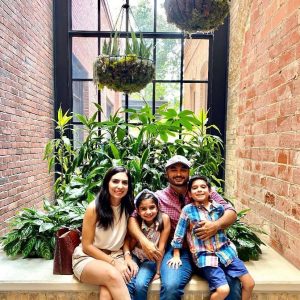
Juan with his family.
AC: Has it changed your perspective?
JG: What has changed my perspective on architecture is that I put more value in the craftsmanship of a building. That happened when I moved to the United States. Before in Monterrey, my preferences were for the contemporary — really simple lines, ‘less is more.’ When I moved to Laredo, and started working with the partners at Able City, I started to appreciate more the historical craftsmanship of older architecture and different styles of Architecture.
AC: Last question, but back to the beginning: did you know any architects growing up?
JG: No, I’m the first one in my family. We didn’t have an architecture school where I grew up, so I didn’t know any architects, but I always knew that I was going to take that path.


